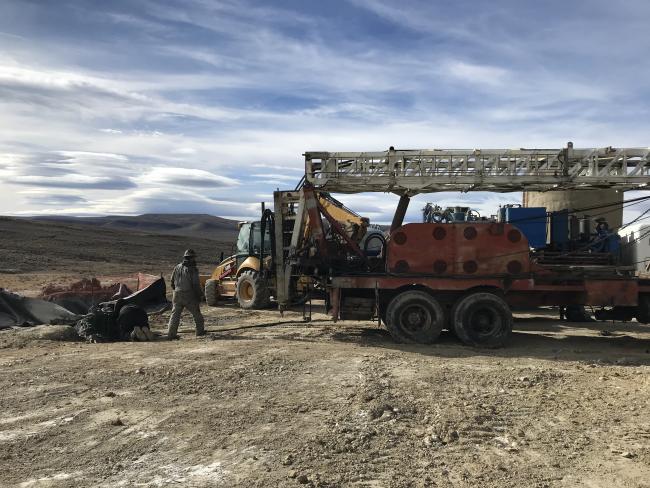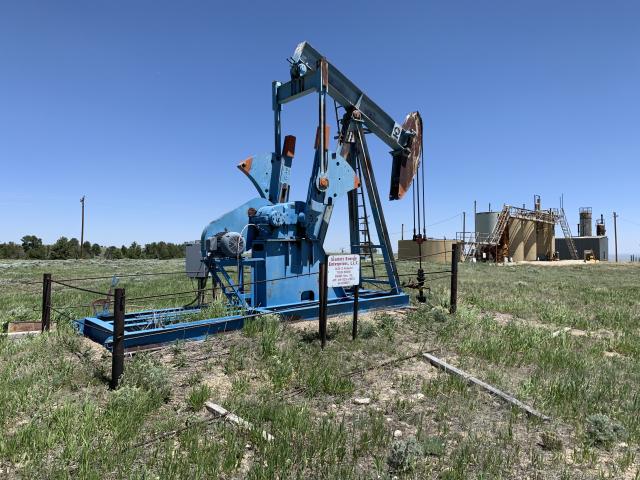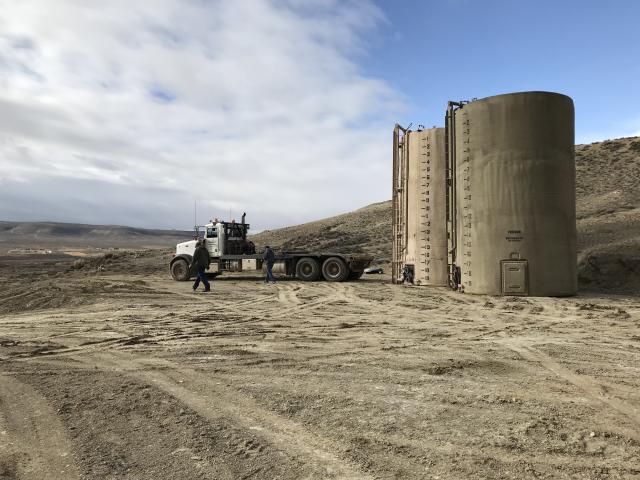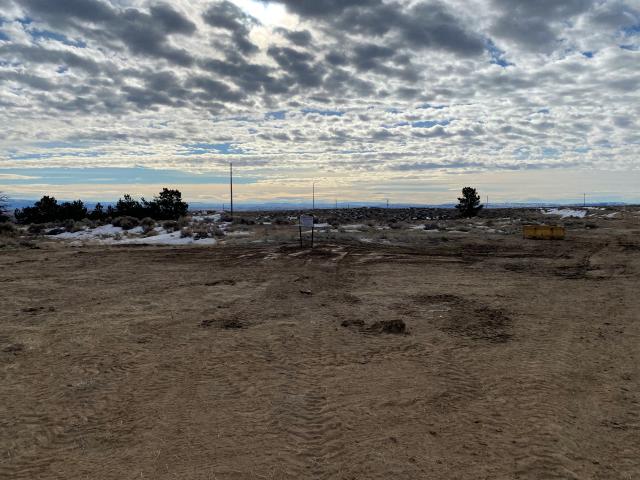Restoring the land through plugging and partnerships: tackling orphaned wells in Wyoming
Listen
Subscribe
Related Content
The BLM's onshore oil and gas program manages oil and natural gas extraction nationwide, bringing in billions of dollars to the U.S. Treasury from productive wells. But what happens if the wells we manage are no longer productive or maintained? This is the question that the Federal Orphaned Well Program is designed to answer. The program seeks to remediate orphaned wells on Federal Lands, as well as support efforts to do so from State and Tribal entities’ plugging programs.
Orphaned wells are oil and gas wells that no longer have a responsible operator to plug and reclaim the surrounding land. When no responsible party exists, the BLM steps in to secure funding and resources to plug the wells, using funds from operators' bonds and legislative programs to contract and clean up abandoned project sites. In these cases, the BLM works with operators to ensure idle wells are either brought back into production or plugged before they become orphaned.
Left unattended and unplugged, inactive oil and gas wells are environmental hazards that jeopardize public health and safety, as well as pose risks to wildlife. Emissions of noxious gases such as methane threaten to contaminate groundwater; unattended drill sites can lead to flooding and sinkholes. To prevent these dangers, the BLM works with contractors to identify, prioritize and plug orphaned wells.
According to the U.S. Environmental Protection Agency, oil and gas well plugging is a multi-step process. Before the actual plugging can begin, specialists must inspect and prepare the site, removing any existing infrastructure and production tubing. Teams then pump strong plugging materials with low permeability, such as cement, deep into the inactive wells. The placement of underground plugs at the oil and gas production zones and water aquifers seals off emissions and prevents contamination. Assuming the plug passes necessary pressure tests, and no adjustments are needed, the well is then capped, and reclamation activities begin.
Reclamation aims to restore the project site to match its surrounding environment, bringing it to a condition equal to or closely approximating that which existed before the land was disturbed. Through ecosystem restoration, including restoration of any natural vegetation, hydrology, and wildlife habitats affected by surface disturbances from construction and operating activities at an oil and gas site, the BLM can ensure that any effects of oil and gas development on the land and on other resources and uses are not permanent.
Plugged and reclaimed orphan well sites have the potential to provide healthy wildlife habitat, recreation opportunities and more. The Orphaned Wells program underscores the importance of responsible land stewardship and the BLM's commitment to environmental restoration. The Department’s Orphaned Wells Program Office’s newly released Strategic Plan, Fiscal Years 2025-2030 communicates how we can serve the orphaned wells community and ensure success in transforming a legacy of environmental pollution into a legacy of environmental stewardship.
Transcript
Transcript:
AZURE HALL (Public Affairs Specialist): One of the BLM's largest programs manages oil and natural gas extraction nationwide. This program brings in billions of dollars to the U.S. Treasury from productive wells. But what happens if the wells are no longer productive? I’m Azure Hall, and this is On the Ground, a Bureau of Land Management podcast. Most of the time, the BLM works with companies who have leased lands for oil and gas extraction to close the wells when they are no longer producing. But some of the wells have been out of production so long they are considered orphaned. This week, I'm talking with Bill Beck, the Fluid Minerals Operations Branch Chief at the BLM's Wyoming State Office in Cheyenne. And Bill, what exactly is an orphaned well?
BILL BECK (Fluid Minerals Branch Chief, BLM Wyoming): So, an orphaned well, that's actually a great question that you lead off with because it's one that there's not a lot of clarity when you listen to the news or literature. An orphaned well, by definition, defined in the Bipartisan Infrastructure Law what it basically says is that if there is no viable entity that can go and plug and reclaim the land around the well an abandoned well, by definition, is an orphaned well. It's a well that has no anyone that can take care of it.
HALL: And where does the BLM's responsibility come in when it comes to orphan wells?
BECK: It gets a little more complicated then. We're working with what actually started out as idle wells. So, we keep track of idle wells, how long they've been idled. We work with operators to try and get wells either under production or plugged without becoming orphaned. And the idea is really for the operators or anybody who's ever had who currently has or who has ever had interest in that lease to plug those wells and in a timely fashion so that we don't have to go back and plug them using taxpayer dollars or legislated/appropriated dollars.
Sometimes those operators are not viable. If the operators aren't viable, then we look at the folks who currently have interest in the lease, if they're available or not, then we would look for folks that have ever had interest in that lease. Pursue them, notify them, and make sure they're aware that you have a liability here. And it's been really cool to do that work, there's a lot of great stories that come around that. You see people who maybe left the industry and let them work together with other folks who had interest in lease. And they come together, figure out how to get that well plugged, and that's been very encouraging to see.
We've also had some very large operators who through their mergers and acquisitions have acquired liability. Obviously not the way they looked at it, I'm sure. But they’re looking at it and thinking, “How do we solve this problem,” you know, “in a more strategic way.” We’d rather not deal with it on a well-to-well basis. So, we rather look at the entire state, how can we come in there and then these large operators have made their own teams dedicated to getting the working well or sorry their idle will problems resolved.
HALL: So, our first step is to reach out to the involved parties, give them an opportunity to plug it, and if that doesn't come to fruition, what does the BLM do next?
BECK: Yes. So that's the point where we flag it as an orphaned well and then we have to look for funding. And its probably good right now to kind of put the numbers together. You know, we hear these large numbers, you know. Millions of wells. Millions of orphaned wells, but those were actually probably more like idle wells there that haven't had the determination whether they've had a viable entity or not.
For example, in Wyoming, we hear anywhere to the order of thousands of wells that are orphaned and actually we've not really had more than about 15 or 20 at any given time that are you know, technically and truly orphaned. So, once they, once it gets that orphan flag, then we start working. As we're doing that, we pull the operators bond, so that'll give us some money to help pay for the orphan plugging process. We'll look for funding out so that we can get the rest of the contractors that we will pay to go out and plug the well. We have folks that come out and validate the work and then validate the plugging.
Then we'll go out and build clean up the land around it so that it restores it back to the habitat that's natural for the land, and ideally the habitat that was there before the well was put in. And so ideally, you know, in short order, we've got the land back to where it was, before the well was drilled and wildlife and recreation, all the folks that love enjoying lands are able to get out there and enjoy it.
HALL: Very cool. Speaking of enjoying the land, do you have a project site that’s your favorite to talk about in terms of the Orphaned Wells program?
BECK: Yeah, well, one of the ones that we did a couple of years ago was a place called Pine Mountain. Honestly, it was the first one that I, it would be the first project I had been a part of here in Wyoming. And I was, like, thinking to myself, “OK, here we go. We’re gonna go out there and it’s gonna be the classic, you know, kind of flat lands with rigs going up and down. But it turns out that it was a privately owned surface. It was actually up on a hill, on a pretty good-sized hill, some might say a mountain. There was only one pass to get up to the top of it. So, you kind of have to walk, you know, go through a pretty rickety road, which was something we were thinking about on the way in. How are we going to get all the equipment up here?
Then when we get to the top, it was fantastic. Antelope, elk, raptors flying around. And then when we got up there, we had a really beautiful, clear, crisp day. And you can see pretty much, what seemed like all of Wyoming. One of those spectacular views. And there are about six or seven wells up there, and it was, you know, going around just well-by-well and sorting up kind of what we needed to do with them. And it seemed like, for the most part, pretty clear. But one of the cool things we found out is that the landowner could still use some of the road infrastructure. They were pretty interested in keeping that.
The landowners were fantastic to work with. There are actually two, there was one well that actually sat over on the separate landowner. There was a power line that was up there, so we had to deal with the power company as well. You know, the important things: make sure gates are closed and make sure we’re being good stewards of the government and being good partners with the landowners. It was really helpful.
This project was actually pretty important because it allowed us to kind of work out the kinks in the system before the Bipartisan Infrastructure Law came out. That BIL legislation provided a lot of money to plug wells. We're still plugging wells currently in Wyoming on BIL dollars. And so, we were actually able to work a lot of the kinks out with that in terms of the contracting, landowner relations, making sure we got all the interest holders and leases. Got all that sorted out and so, you know, by the time the BIL money came down, we were really kind of rolling along quite nicely.
It was a good project. We did find some things that were a little shocking, that we weren't expecting. There were a couple of gas lines that were kind of quasi on the surface, you know, kind of somewhat buried where we didn't see where they were permitted. These both, mind you, were drilled back in the 50s and had been abandoned for quite a while.
The landowners were extremely patient. I think they were pretty excited when they heard we were going to come out there and finally be able to get those wells plugged and you know, let they let you. They did a great job appreciating where our perspective was on, you know, we'd rather not use taxpayer dollars to plug them, but recognizing then we can finally get the project together. They seem to be pretty happy.
The field office was very, very happy to get them done. They've been trying to figure out how to get them done for quite some time. And so, it was a good project overall. When you take the infrastructure off the land, it's amazing what the land can look like. And when you took all the pumpjacks off and the facilities off, there was a lot. It was very beautiful. And I'm sure the wildlife was just having a lot better time out there getting around not have to worry about dancing around a pumpjack or whatnot.
HALL: Very cool. Yeah, it seems like with the developing and strengthening relationships that you mentioned, I mean, between the field office and landowners and power companies; there's a lot of collaboration and a lot of momentum behind the program. It's encouraging.
BECK: I would be remiss if I didn't talk about our relationship with the state. From 2017 to about 2021, we had a great working relationship with them. It turned out that our fiscal years were different and so that allowed us to kind of work more efficiently in terms of getting wells contracted and plugged. We contracted and plugged dozens, certainly dozens, if not hundreds, of wells during that time. So, we continue to work with them, just kind of making sure that we're not doubly planning to plug or reclaim a piece of land or a well, and they've been great partners. So, we definitely appreciate that.
HALL: Thank you so much for taking the time to chat with me today, Bill. I think we covered a lot, but there's always more to learn when it comes to the BLM's role in energy production and responsible land stewardship. On our website for this episode, we'll have information about the orphan well program as well as other helpful resources for interested listeners. I'm Azure Hall, thanks for joining me. And we'll see you next time, On the Ground.





